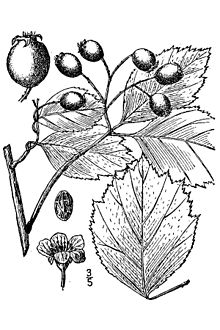Crataegus douglasii
 From Wikipedia the free encyclopedia
From Wikipedia the free encyclopedia
| Crataegus douglasii | |
|---|---|
 | |
| Scientific classification | |
| Kingdom: | Plantae |
| Clade: | Tracheophytes |
| Clade: | Angiosperms |
| Clade: | Eudicots |
| Clade: | Rosids |
| Order: | Rosales |
| Family: | Rosaceae |
| Genus: | Crataegus |
| Species: | C. douglasii |
| Binomial name | |
| Crataegus douglasii | |
 | |
| Natural range of Crataegus douglasii | |
| Synonyms | |
| C. brockwayae Sarg.[1] | |
Crataegus douglasii is a North American species of hawthorn known by the common names black hawthorn and Douglas' thornapple. It is most abundant in the Pacific Northwest.
Description[edit]
Crataegus douglasii is a compact erect bushy shrub growing to 8–9 metres (26–30 feet) tall with a trunk of up to 10 centimetres (4 inches) thick.[3] It is covered in fan-shaped green leaves about 2.5–5 cm (1–2 in) long[3] with teeth along the distal margin. Thorns along the branches are 1–2.5 cm long.[3]
White flowers with greenish centers grow in bunches at the ends of each thin branch. The fruit is a blackish pome up to about 1 cm across, containing 3–5 rocklike seeds.[3]
Taxonomy[edit]
The species is named after David Douglas, who collected seed from the plant during his botanical explorations.[4]
Formerly placed within the species, Crataegus douglasii var. duchesnensis is now considered to be a synonym of Crataegus saligna.
Distribution[edit]
The thorny shrub is native to northern and western North America, where it grows in varied habitats from forest to scrubland. It is most abundant in the Pacific Northwest.
Ecology[edit]
The foliage is browsed by cattle and sheep. Various birds, including quail, the Hungarian partridge, and ring-necked pheasant feed on the berries,[4][5] as do bears and other animals.[3] Magpies nest in the branches.[3] The species is a larval host to the gray hairstreak, mourning cloak, pale tiger swallowtail, and western tiger swallowtail.[6]
Uses[edit]
The fruits were a good food source for Native American peoples such as the Cheyenne and Nlaka'pamux.[citation needed]
Gallery[edit]
- Straight, stout thorns are one to two centimeters long.[7]
- The white flowers have greenish centers.
- Crataegus douglasii
- The leaf margin is toothed and usually slightly lobed.
- Crataegus douglasii leaves changing color in fall.
- The mature bark is grey and rough.[8]
- Crataegus douglasii
- Crataegus douglasii JEPS109866 (4496863581)
See also[edit]
References[edit]
- ^ Kruschke, E.P. (1965). "Contributions to the taxonomy of Crataegus". Milwaukee Public Museum Publications in Botany. 3: 11–273.
- ^ Phipps, J.B. (1995). "The identity of Crataegus columbiana and its relationship to C. piperi (Rosaceae)". Taxon. 44 (3): 405–8. doi:10.2307/1223414. JSTOR 1223414.
- ^ a b c d e f Arno, Stephen F.; Hammerly, Ramona P. (2020) [1977]. Northwest Trees: Identifying & Understanding the Region's Native Trees (field guide ed.). Seattle: Mountaineers Books. pp. 248–249. ISBN 1-68051-329-X. OCLC 1141235469.
- ^ a b Whitney, Stephen (1985). Western Forests (The Audubon Society Nature Guides). New York: Knopf. p. 392. ISBN 0-394-73127-1.
- ^ Peattie, Donald Culross (1953). A Natural History of Western Trees. New York: Bonanza Books. p. 519.
- ^ The Xerces Society (2016), Gardening for Butterflies: How You Can Attract and Protect Beautiful, Beneficial Insects, Timber Press.
- ^ "Crataegus douglasii". WTU Herbarium Image Collection. Burke Museum, University of Washington. Retrieved 2009-12-12.
- ^ Pojar, Jim; Andy MacKinnon (1994). Plants of the Pacific Northwest. Lone Pine. p. 73. ISBN 1-55105-042-0.
External links[edit]
- Jepson Manual Treatment - Crataegus douglasii
- U.Mich: Ethnobotany
- Crataegus douglasii - Photo gallery
![Straight, stout thorns are one to two centimeters long.[7]](http://upload.wikimedia.org/wikipedia/commons/thumb/0/0a/Crataegus_douglasii_9816.JPG/80px-Crataegus_douglasii_9816.JPG)




![The mature bark is grey and rough.[8]](http://upload.wikimedia.org/wikipedia/commons/thumb/f/f4/Crataegus_douglasii_mature_bark.jpg/104px-Crataegus_douglasii_mature_bark.jpg)



